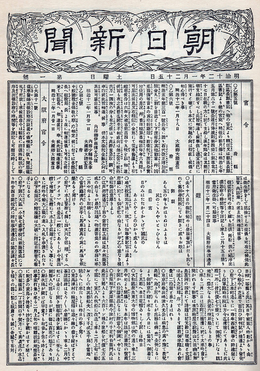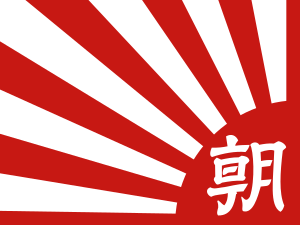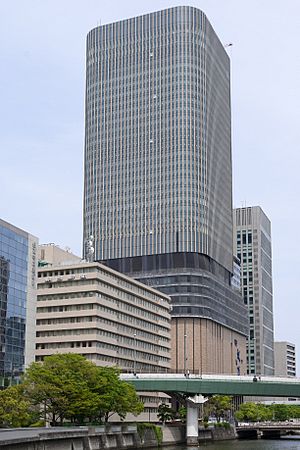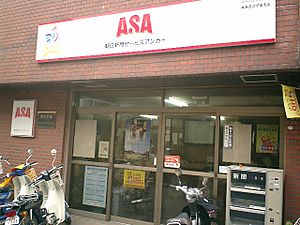The Asahi Shimbun facts for kids

First issue on 25 January 1879
|
|
| Type | Daily newspaper Company type: Private |
|---|---|
| Format | Blanket (54.6 cm x 40.65 cm) |
| Owner(s) | Repurchased shares (25%) Murayama family (21.02%; 10% through the KOSETSU Museum of Art) Ueno family (total 14.22% by Shōichi Ueno's death in 2016) TV Asahi (11.88%) Toppan (7.31%) Asahi Broadcasting Group Holdcorp (2.31%) |
| Founder(s) | Murayama Ryōhei Ueno Riichi |
| Founded | January 25, 1879 |
| Political alignment |
|
| Headquarters | Nakanoshima, Kita-ku, Osaka, Japan |
| Country | Japan |
| Circulation |
|
The Asahi Shimbun (朝日新聞, IPA: [asaçi ɕiꜜmbɯɴ], lit. morning sun newspaper) is a major daily newspaper from Japan. It was started in 1879. It is one of the oldest newspapers in Japan and Asia. Many people consider it a very important source of news for Japan.
The Asahi Shimbun is one of the five biggest newspapers in Japan. The others are the Yomiuri Shimbun, the Mainichi Shimbun, the Nihon Keizai Shimbun, and Chunichi Shimbun. In July 2021, its morning edition sold 4.57 million copies. Its evening edition sold 1.33 million copies. This made it the second largest newspaper in Japan, after the Yomiuri Shimbun. It is also the second largest newspaper in the world by print copies.
The company that publishes the newspaper is called The Asahi Shimbun Company. It is a large media group based in Osaka. It is a private company, meaning its shares are not traded on a stock exchange. The founding families, Murayama and Ueno, still own and control it.
Contents
History of Asahi Shimbun
How the Newspaper Started
The Asahi Shimbun is one of Japan's oldest and largest national daily newspapers. It began in Osaka on January 25, 1879. It was a small, four-page paper with pictures. Each copy cost one sen, which was a very small amount of money back then. About 3,000 copies were printed each day.
The company had three main leaders and twenty staff members. They were Kimura Noboru (president), Murayama Ryōhei (owner), and Tsuda Tei (managing editor). The first office was in Osaka. On September 13, 1879, Asahi printed its first editorial, which is an article that shares the newspaper's opinion.
In 1881, Asahi changed to an all-news format. Ueno Riichi joined as a co-owner. The newspaper started getting financial help from the government and a big company called Mitsui. This helped Asahi grow stronger. Under the leadership of Ueno and Murayama, the newspaper became famous across Japan. On July 10, 1888, the Tokyo Asahi Shimbun was first published from Tokyo.
In 1907, a famous writer named Natsume Sōseki joined the Tokyo Asahi Shimbun. He was 41 years old and had already written popular novels like I Am a Cat and Botchan. On October 1, 1908, the Osaka and Tokyo Asahi Shimbun newspapers joined together. They formed one company called Asahi Shimbun Gōshi Kaisha.
In 1918, the newspaper was critical of the government during the Rice Riots. Because of this, the government stopped one of its articles from being published. This led to some staff members leaving in protest. The newspaper's liberal views also caused it to be attacked by extreme nationalist groups many times throughout its history.
During World War II
In the late 1930s, Asahi supported Prime Minister Fumimaro Konoe's government during the war. It also criticized capitalism. Important writers for Asahi were part of a group that advised Konoe. One of them, Hotsumi Ozaki, was later found to be a spy.
In 1937, a Mitsubishi airplane called the Kamikaze, sponsored by Asahi Shimbun, flew to London. This was a big surprise to the world. It was the first Japanese-built plane to fly all the way to Europe.
On September 1, 1940, the Osaka Asahi Shimbun and the Tokyo Asahi Shimbun officially became one newspaper called Asahi Shimbun. In 1943, the government stopped the newspaper's publication for a short time. This happened after it printed an article that criticized the government.
After the War
After World War II ended, on November 5, 1945, the president and other top leaders of Asahi Shimbun resigned. They took responsibility for how the newspaper acted during the war.
On November 21, 1946, the newspaper started using a modern Japanese writing system. On November 30, 1949, Asahi Shimbun began publishing the popular cartoon strip Sazae-san. This cartoon became a very important part of Japan's culture after the war.
Between 1954 and 1971, Asahi Shimbun published an English magazine called This is Japan. In 1989, the newspaper reported that a coral reef near Okinawa was damaged. It was later found that the reporter himself had damaged the reef. This caused the president to resign.
From 2001 to 2011, Asahi Shimbun worked with the International Herald Tribune to publish an English newspaper. This newspaper was called the International Herald Tribune/Asahi Shimbun. Now, Asahi Shimbun has an online English news portal called Asia & Japan Watch.
Political Views
The Asahi Shimbun is generally seen as a newspaper with progressive or social-liberal views. It often reports on big political scandals. The paper is considered a very important source of news in Japan.
The Asahi Shimbun is critical of extreme Japanese nationalism. It supports cultural and diplomatic issues that are more open and modern. However, it has some neoliberal economic ideas. Overall, it represents a social-liberal viewpoint in Japan.
The Asahi strongly supports Japan's postwar Constitution. It especially supports Article 9, which says Japan cannot use war to solve problems. The newspaper has also opposed changes to this rule.
A 2018 study showed that Asahi had the lowest trust among the five largest newspapers in Japan. This was partly because it received strong criticism from conservative groups in Japan.
Asahi Shimbun Asia Network
The Asahi Shimbun Asia Network (AAN) is a group that works to share information in Asia. It helps scholars, researchers, and journalists talk about important topics in Asia. It was started in 1999. They hold yearly international meetings and publish research reports.
Asahi Prize
The Asahi Prize was started in 1929. It is an award given by the newspaper, and since 1992 by the Asahi Shimbun Foundation. It honors people who have made important contributions to Japanese culture or society through their studies or art.
Past Issues and Archives
You can find old issues of the Asahi Shimbun in a few ways. They are available on CD-ROMs, on microfilm, and as shukusatsuban. Shukusatsuban are special reduced-size print editions. Asahi Shimbun made these popular in the 1930s. They allow many pages of a newspaper to fit onto one page, making it easier to store. These are often used by libraries and archives.
Many universities around the world have these resources. They are especially found at universities with good Japanese studies programs. There is also a digital database of Asahi Shimbun issues from August 1984 onwards available through Lexis-Nexis Academic.
Offices Around Japan
- Osaka Head Office (main office): Nakanoshima Festival Tower East, 3-18, Nakanoshima Nichome, Kita-ku, Osaka
- Tokyo Head Office: 3-2, Tsukiji Gochome, Chūō, Tokyo
- Hokkaidō Office: 1-1, Kita-Nijo-nishi Itchome, Chūō-ku, Sapporo
- Nagoya Head Office: 3-3, Sakae Itchome, Naka-ku, Nagoya
- West Head Office: Riverwalk Kitakyushu, 1-1, Muromachi Itchome, Kokura Kita-ku, Kitakyushu
- Fukuoka Office: 1-1, Hakata Ekimae Nichome, Hakata-ku, Fukuoka
Images for kids
Sports Sponsorships
Asahi Shimbun has supported many sports events. They were an official supporter for several Asian Football Confederation competitions. This included the 2019 AFC Asian Cup. They also supported the AFC Champions League and AFC Cup until 2018. They were official sponsors of the 2002 FIFA World Cup.
Related Companies
- Nikkan Sports
- Kanagawa Shimbun
- International Herald Tribune/The Asahi Shimbun (Herald-Asahi)
- Asahi Shimbun Publications (formerly Asahi Sonorama)
- TV Asahi Holdings (a major shareholder in the newspaper)
- Asahi Broadcasting Corporation
- All-Nippon News Network
- TV Asahi Channel (pay TV channels)
- Asahi Shimbun Foundation
- FM OSAKA
See also
 In Spanish: Asahi Shimbun para niños
In Spanish: Asahi Shimbun para niños
- Media of Japan
- Asahi characters
- Rising Sun Flag
- Kuri-chan, a four-panel comic strip that ran in the newspaper from 1951 to 1965
- Tensei Jingo








